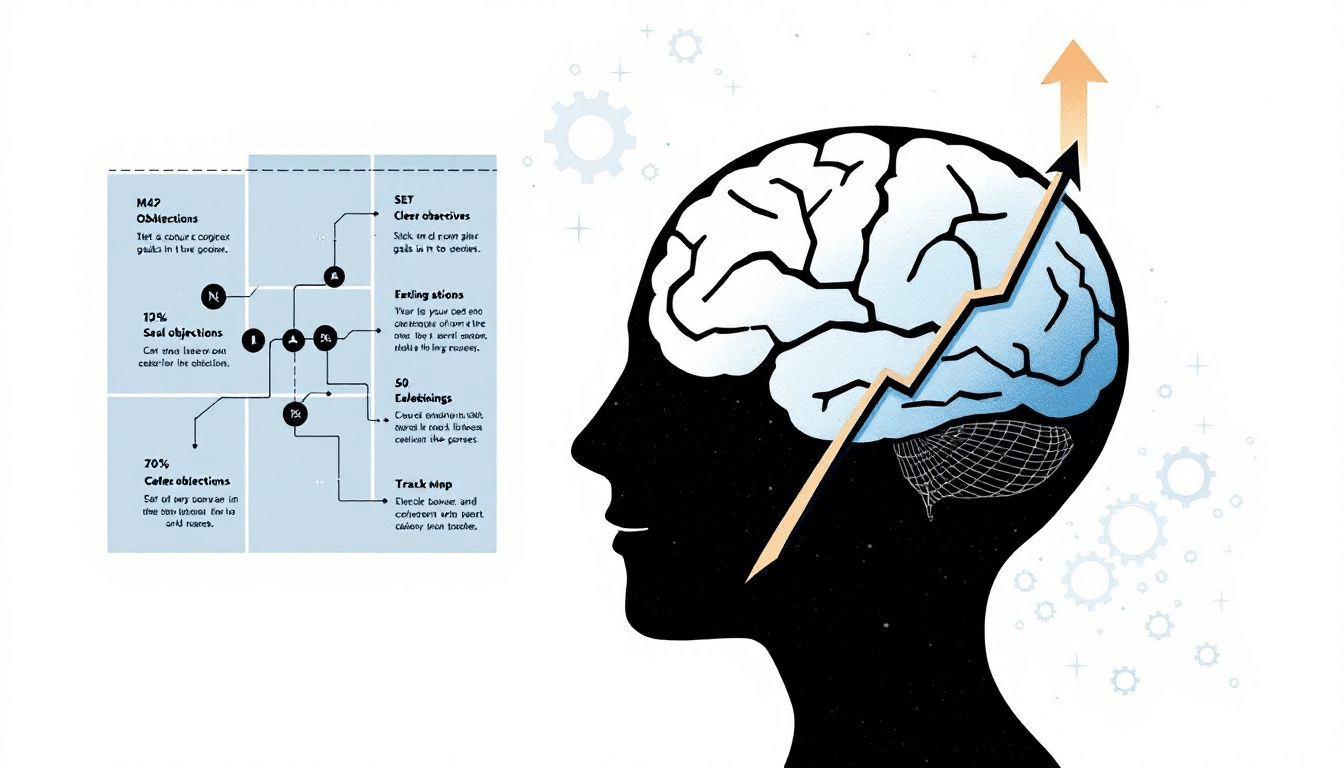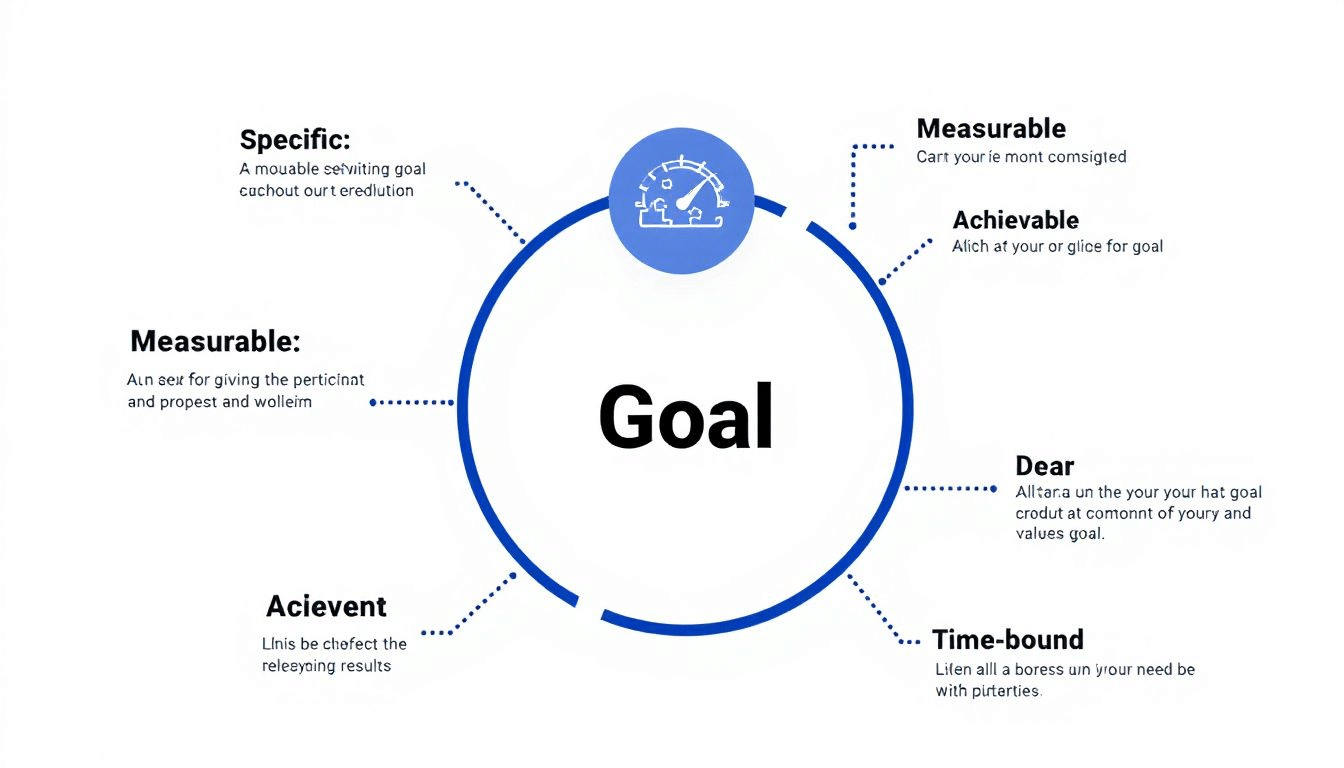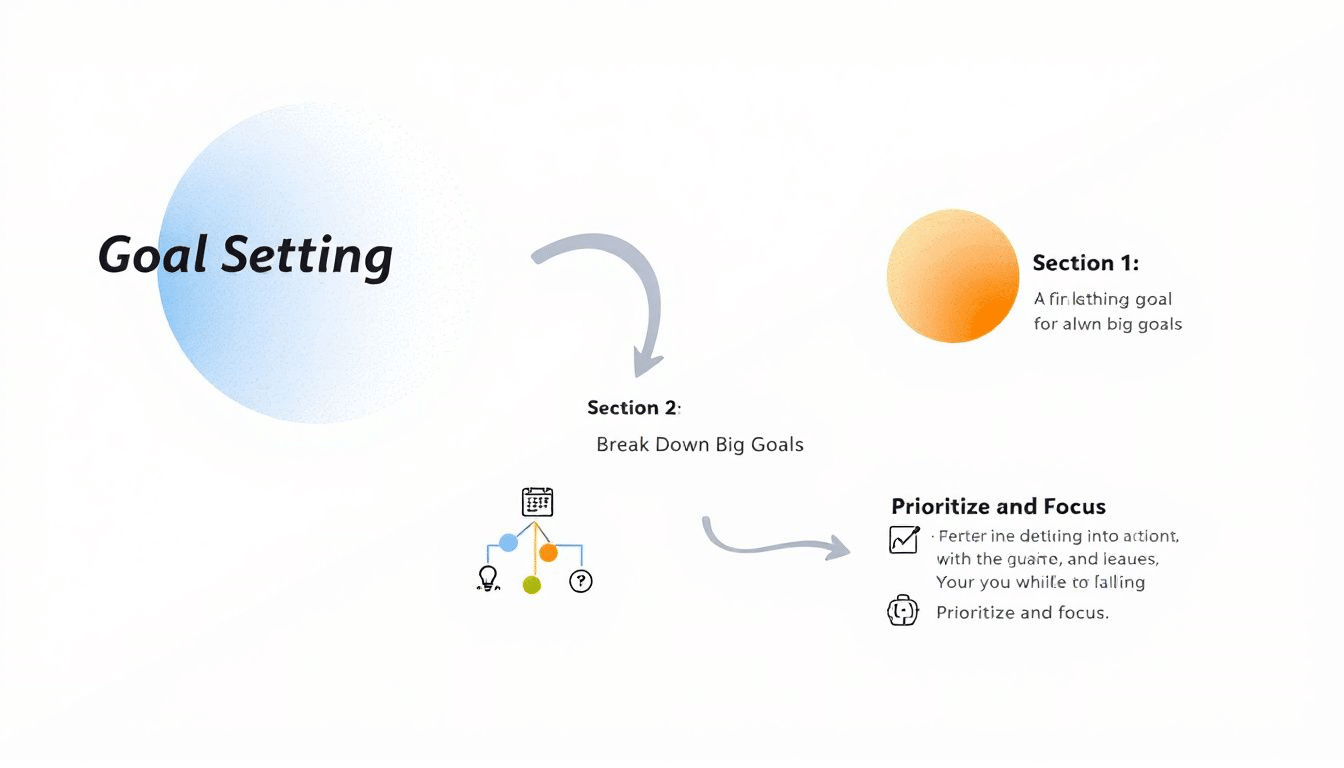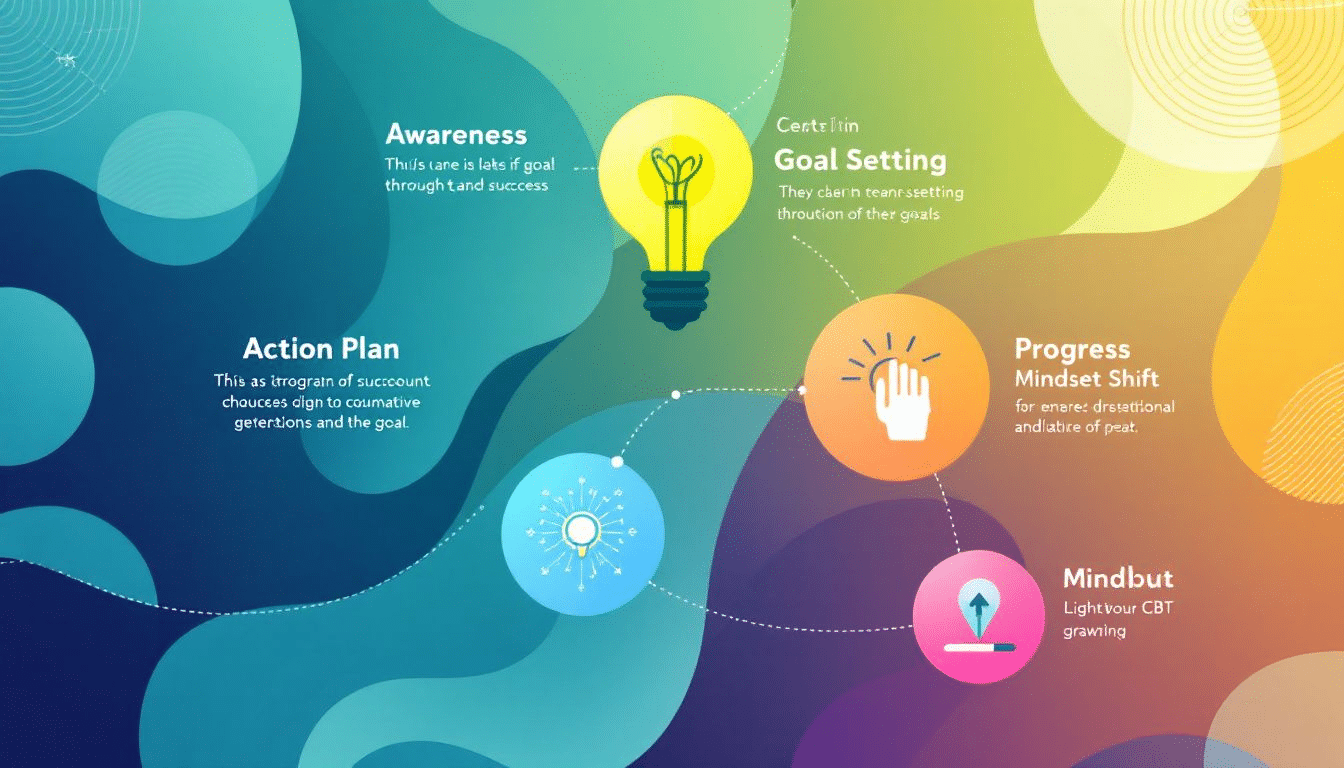Cognitive Behavioral Therapy (CBT) revolves around setting clear, achievable goals to foster personal growth. Want to make real progress? This article guides you through cognitive behavioral therapy goal setting, explains the SMART criteria, and provides actionable tips to help you succeed.
Key Takeaways
Goal setting is essential in Cognitive Behavioral Therapy (CBT) as it provides direction, motivation, and a structured approach to achieving long-term behavioral changes.
Utilizing the SMART criteria—Specific, Measurable, Achievable, Relevant, and Time-bound—ensures that goals are effective and trackable, enhancing client engagement in the therapeutic process.
Breaking down long-term goals into manageable steps maintains motivation and promotes a sense of accomplishment, while regular monitoring and adjustment of goals allow for tailored therapeutic progress.
Understanding the Importance of Goal Setting in CBT

Goal setting plays a crucial role in Cognitive Behavioral Therapy (CBT). It provides clients with direction, motivation, and purpose throughout their therapeutic journey. Similar to a compass guiding a ship, setting goals helps clients navigate the turbulent waters of behavioral change and personal growth. Clear and realistic goals enable clients to achieve long-term behavioral changes and significant personal development.
Effective goal setting in CBT provides clients with a defined focus, making their therapeutic journey more structured and purposeful. Realistic and achievable goals lead to tangible progress, boosting self-efficacy and motivation. This sense of accomplishment helps maintain engagement and commitment to the therapeutic process.
Additionally, goal setting enables measurable progress, which keeps clients motivated and engaged. Positive goal expression enhances commitment, increasing motivation and clarity. Achieving goals often gives clients a sense of control and success, alleviating feelings of hopelessness and despair.
Focusing on the process of pursuing goals rather than solely on outcomes can prevent exacerbation of depressive symptoms and promotes a sense of ownership and agency. Clearly defined goals serve as a roadmap for success, keeping clients motivated and committed to their therapy.
The SMART Criteria for Effective Goal Setting

CBT employs the SMART criteria—Specific, Measurable, Achievable, Relevant, and Time-bound—to ensure goals are effective. This framework offers a structured approach to goal setting, making it easier for clients to track their progress and achieve their objectives using cbt techniques.
Specific goals are clear and well-defined, targeting particular issues or behaviors. For example, instead of a vague goal like “reduce anxiety,” a specific goal would be “practice deep breathing exercises for 10 minutes daily to manage anxiety symptoms.” This clarity helps clients focus their efforts and makes the goal more attainable.
Measurable goals enable clients to track their progress, making it easier to evaluate success. Setting benchmarks and using tools like progress charts or journals allows clients to see their improvements and stay motivated.
Achievable goals fit within the client’s current resources and circumstances, ensuring they are realistic and attainable. Relevant goals align with the client’s values and broader objectives in therapy, making them meaningful and significant to the client’s overall growth.
Time-bound goals create a sense of urgency and motivation by incorporating a specific deadline. This aspect of the SMART criteria helps clients stay focused and committed to achieving their goals within a set timeframe.
Techniques for Identifying and Setting Goals
Goal setting in CBT is a collaborative process between the client and the therapist, ensuring goals are relevant and engaging for the client, thereby increasing commitment to the therapeutic process. Working with a CBT therapist provides valuable insights and recommendations for setting personalized goals.
Aligning goals with personal values makes them meaningful and satisfying. Clients who set goals based on their values are more likely to find greater satisfaction in their achievements. This alignment enhances motivation and engagement, as clients see the direct impact of their efforts on their personal growth and well-being.
Using tracking tools like worksheets, journals, or apps significantly enhances progress monitoring. These tools allow clients to document their journey, track their progress, and reflect on achievements and challenges. Highlighting actions that align with established goals helps clients stay focused and monitor their progress.
Through self-discovery and goal setting, clients can identify specific issues and develop coping skills to address them. Techniques such as relaxation exercises and cognitive restructuring can be incorporated into therapy, helping clients manage their emotional regulation, thought, behavior patterns, and maladaptive behaviors more effectively.
Breaking Down Long-Term Goals into Manageable Steps

Breaking down long-term goals into manageable steps is a crucial CBT strategy. Establishing short-term goals enhances clients’ motivation and provides a sense of accomplishment. For example, a client aiming to improve physical health might start with exercising for 10 minutes daily, gradually increasing the duration as stamina builds.
A well-structured smart goals makes it easier for individuals to incorporate healthy behaviors into their routines. For instance, transforming a general goal like “live a healthier life” into specific steps such as “eat a balanced diet and exercise regularly” can significantly improve focus and commitment. This specificity helps clients address particular behaviors or issues more effectively.
Accomplishing small steps is essential for maintaining motivation while working towards a goal. Dividing long-term goals into smaller, manageable pieces allows clients to experience regular successes, boosting confidence and encouraging them to continue striving towards their overall objectives. This approach helps clients manage their progress and stay motivated throughout their therapeutic journey.
Monitoring Progress and Adjusting Goals

Monitoring progress and adjusting goals is a crucial part of the CBT process. Self-monitoring involves tracking behaviors, symptoms, or experiences over time, enabling clients to recognize their progress and challenges. This practice provides valuable information for therapists, allowing them to tailor treatment based on the client’s specific data.
Various tools can effectively track progress in therapy. Journaling, checklists, and progress charts are some examples. Clients can document their thoughts and behaviors, reflect on setbacks and victories, and gain a comprehensive view of their journey. This reflection helps clients stay focused on their goals and adjust their strategies as needed.
Regularly reviewing and revising goals adapts them to changing needs and circumstances during therapy. An ongoing review process ensures that treatment goals remain relevant and appropriately challenging for clients. Open communication between clients and therapists is vital for identifying and overcoming obstacles in the treatment process.
Common Challenges in Goal Setting and How to Overcome Them
Goal setting in CBT can present several challenges, but with the right strategies, these obstacles can be overcome. One common challenge is feeling overwhelmed by the size of the goal or not knowing where to start. Breaking down large goals into smaller, manageable steps helps alleviate this feeling and provides a clear starting point for clients.
Setting realistic goals contributes to their effectiveness in achieving desired outcomes. Unrealistic goals can lead to discouragement and failure, so it is important to set achievable targets that clients can realistically accomplish within their current circumstances. This approach maintains motivation and fosters a positive cycle of success.
Adopting a self-compassionate approach in goal setting significantly enhances motivation and sustained progress. Clients who are kind to themselves and acknowledge their efforts are more likely to stay motivated and continue striving towards their goals. Additionally, open communication between therapists and clients helps identify barriers or challenges and develop strategies to overcome them.
Another challenge is the struggle with introspection and recognizing automatic negative thoughts and negative thought patterns. Awareness alone does not facilitate change; clients must work with their therapists to develop coping skills and techniques to address these thoughts. By anticipating potential obstacles, clients can avoid hindering their goal achievement and stay on track towards their overall objectives.
Success Stories: Significant Progress Through Goal Setting in CBT

The power of goal setting in CBT is evident in numerous success stories. A study indicated that 70% of participants reported significant improvements after just eight weeks of CBT group therapy, highlighting the effectiveness of goal setting in achieving tangible progress. These results demonstrate the potential for rapid and substantial change through CBT’s structured approach.
Effective goal setting in CBT can lead to significant behavioral changes and improvements in mental health conditions. For example, clients dealing with post-traumatic stress disorder (PTSD) or anxiety disorders have reported remarkable progress by setting and achieving specific goals. This approach helps clients manage symptoms and develop healthier coping mechanisms.
One client, for instance, overcame substance use disorders by setting small, achievable goals and gradually building on successes. Another client dealing with eating disorders experienced significant changes by focusing on specific goals related to eating habits and self-perception.
These success stories illustrate the transformative power of goal setting in CBT and its ability to foster lasting change and personal growth.
Summary
In summary, goal setting is a fundamental aspect of Cognitive Behavioral Therapy (CBT) that provides direction, motivation, and a sense of purpose. By utilizing the SMART criteria, clients can set specific, measurable, achievable, relevant, and time-bound goals that enhance their therapeutic journey. Techniques for identifying and setting goals, breaking down long-term goals into manageable steps, and monitoring progress are essential for achieving personal growth and lasting change.
By overcoming common challenges and learning from success stories, individuals can harness the power of goal setting to transform their lives. Whether dealing with anxiety, depression, or other mental health conditions, effective goal setting in CBT can lead to significant improvements and a brighter future.
Frequently Asked Questions
What is the importance of goal setting in CBT?
Goal setting in CBT is crucial as it provides direction, motivation, and a sense of purpose, facilitating long-term behavioral change and personal growth. This structured approach enhances the effectiveness of therapy and empowers clients to make meaningful progress.
How does the SMART criteria help in goal setting?
The SMART criteria enhance goal setting by ensuring that goals are Specific, Measurable, Achievable, Relevant, and Time-bound, which facilitates clarity and trackability. Employing this framework increases the likelihood of achieving set objectives.
What techniques can be used to identify and set goals in CBT?
To effectively identify and set goals in Cognitive Behavioral Therapy (CBT), one should collaborate with a therapist, ensure goals align with personal values, utilize tracking tools, and emphasize self-discovery. These techniques facilitate a clearer path towards achieving meaningful objectives.
How can I break down long-term goals into manageable steps?
To effectively break down long-term goals, utilize the SMART framework to create specific, measurable, achievable, relevant, and time-bound short-term goals, while dividing those into smaller, actionable steps. This approach will facilitate manageable progress towards your overarching objectives.
What are common challenges in goal setting, and how can they be overcome?
Common challenges in goal setting include feelings of overwhelm, unrealistic targets, and difficulties with self-reflection. These can be overcome by breaking down goals into manageable steps, setting achievable targets, practicing self-compassion, and engaging in open communication with a therapist.


